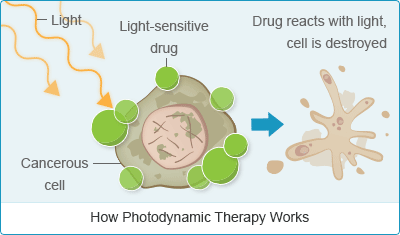Photodynamic Therapy: Cancer
Photodynamic therapy is a treatment that uses a drug called, photosensitizer and a certain type of light. When the photosensitizers are exposed to a specific wavelength of light, they produce a form of oxygen that kills nearby cells.
First a photosynthesizer is injected into the bloodstream. While the photosensitizer is in the bloodstream, it is absorbed by cells but when it cancer cells it stays inside the cancer cell longer than a normal cell. In about 24-72 hours after the injection, most of the photosensitizer left the normal cells but remain inside the cancer cells....
How is Photodynamic therapy used to treat cancer?

First a photosynthesizer is injected into the bloodstream. While the photosensitizer is in the bloodstream, it is absorbed by cells but when it cancer cells it stays inside the cancer cell longer than a normal cell. In about 24-72 hours after the injection, most of the photosensitizer left the normal cells but remain inside the cancer cells. Finally, The tumor is exposed to light, which is absorbed by the photosensitizer, which starts a mass production of oxygen to kill the nearby cancer cells.
Limits and Side Effects
First, the cancer cells can only be photosentized if its 1 cm under the skin lining. Also, After an successful Photodynamic Treatment, it is advised that you avoid direct sunlight and bright indoor lights. Other side effects like, coughing, trouble swallowing, stomach pain, painful breathing, or shortness of breath, are usually temporary.
